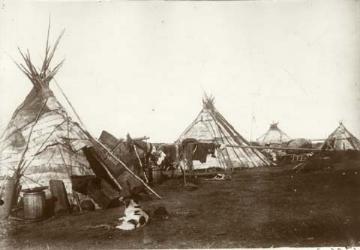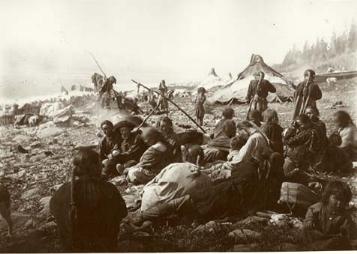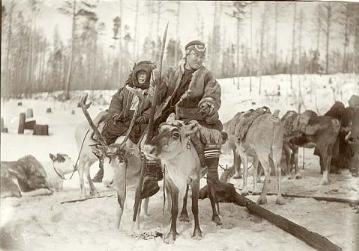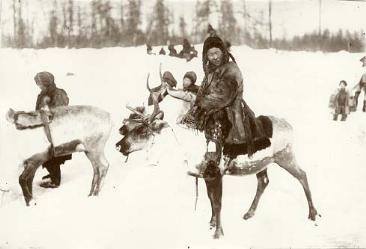
Nomadic lifeways of reindeer breeders and hunters structured the development of essential forms of material culture such as portable framework dwellings (i.e., the chum and yaranga), mobile transport (narty), and clothing for breeders and hunters. Construction and architectural forms of portable dwellings were closely connected with climatic conditions and environmental settings. The main dwelling of groups in Western Siberia (i.e., the Nenets, Khants, Mansis, Dolgans, Nganasans, and Sel'kups) and in Eastern Siberia (i.e., the Evenks, Evens, Kets, and northern Yakuts) was a chum of conical shape. The framework of the chum consisted of long poles made from thin tree trunks 2.5 to 5 meters high, arranged in a circle.
A Khant summer village with chums covered with birch bark, 1909-1910. No. 1706-3.

When a dwelling was constructed, these long poles were supported by two or three major poles placed in the center of the circle. The main poles, being the pivot of the chum, determined the size and the number of poles required for the construction of the dwelling. The larger chums had sixty poles; the smaller chums had twenty-five to thirty poles. The framework of the chum was covered from above. The material from which these were made depended on the kind of economic activity, geographic conditions, and season of the year. Winter covers were sewn of shorn deer hides, and summer covers were made of cured deer hides without nap. Eighteen to twenty-two hides were required for one cover. Mansis, Khants, forest-dwelling Nenets, Evenks, Evens, and Yakuts living in the northern taiga covered their conical dwellings in summer with bands or robes of birch bark. Such covers retained warmth during cold weather and maintained coolness during hot weather. The Evenks, taiga hunters who had at their disposal a small number of domestic transport reindeer and abundant natural resources, covered their chum in winter with tree bark or cured deer hides, and in summer with birch bark or grass.
Evenk summer camp, early 1900s. No 5659-66.

The climatic conditions and geographic environment of the Chukotka Peninsula and Kamchatka had an impact on the development of construction characteristics of the portable frame dwelling, the yaranga. Its cylindrical shape made it more steady in strong gusty winds. The framework of the yaranga consisted of three long, major poles driven into the ground and connected at their apex. Wooden tripods, upon which the poles of the roof were leaned, were set vertically around the main poles. From the top, the framework of the yaranga was covered by two trapezium-shaped covers made of reindeer hides, their nap cut from the outside. Inside the yaranga, fur sleeping canopies of rectangular shape with a height of 1.3 to 1.5 meters were hung opposite the entrance and on the sides. Yarangas with fur covers functioned as winter and summer dwellings for the reindeer-breeding Chukchis and Koryaks.
Khants migrating using a team of
harnessed reindeer and a sled, 1909-1910. No. 1706-72.
Reindeer was the main means of transportation for hunters and reindeer breeders of the Far North of Siberia. The use of reindeer for riding by reindeer herders was characteristic of the taiga inhabitants, the Evenks, and the Evens. Taiga reindeer were larger and more massive than tundra reindeer. They could endure not only a man's weight but also a large pack load. The Evenks and Evens used reindeer as a means of transportation throughout the year. The Dolgans, however, lead a nomadic life and transported loads only during the summer. Human populations of the tundra and forest-tundra zone moved and transported loads on reindeer harnessed to sleds. In western Siberia reindeer sleds were used year round. Two or three animals were harnessed to the reindeer sled in winter, and as many as five in summer. The Northern Yakuts, Chukchis, and Koryaks used reindeer harnesses only in winter and harnessed two reindeer to a sled for riding and one reindeer to a sled for transporting loads.
Evenks riding reindeer during migration, early 1900s. No. 5659-40.
Reindeer hides were used as covers for dwellings, for manufacture of various utensils, and as material for clothes. Coats of Far Northern peoples were of two types: 1) those without a cut in front, with or without a hood, and 2) those with a cut in front. The first type is characteristic of men's and women's clothes of northeastern populations and of western Siberian hunters. Clothes of the second type were used by women of western Siberia as well as by men and women of the eastern Siberian taiga zone. There were some peculiar features characteristic of women's and children's clothing of northeastern Siberia. In the summertime, and particularly in winter, they wore overalls of cured reindeer hides and reindeer hides with nap. For decoration, people of Siberia's Far North used fur of reindeer, skins of small fur-bearers, fabric, leather, seed beads, and colored threads. The major techniques of decorative design were "fur mosaic," embroidery with beads and colored threads, appliqué work of leather and cloth, pendants of seed beads, and fur of different colors.
Evenks riding reindeer
during migration, early 1900s. No. 5659-42.


Evenk girl riding a reindeer, early 1900s. No. 5659-48.